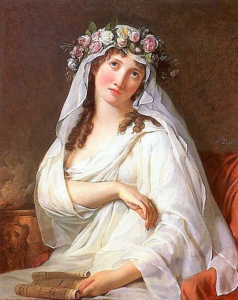November 22nd, 2022
The Romans may be gone, but their influences are not. Roads, plumbing and laws are the well known answers, however Romans are also known for their ceremonious take on events including the fashion trends on weddings and funerals.
The white in a wedding dress connotes purity and chastity of the woman as she is brought into holy matrimony. This theme was first seen with Romans as the woman imitated the goddess Vesta (Hestia in Greek), who was the virgin goddess for home, hearth and family. The symbolic purity of the white dressed bride represents her untainted pure virginity. The point of revealing virginity shows abstinence, demonstrating that she is giving her entire self to her new married significant other.
Photo from celebratepaganholidays.com
Colour variation for the sake of colour variation has also been a popular idea, such as black or red wedding dresses. While black is a typical funeral attire colour, sometimes the hardcore goths do not forgo their true colour on their special day for the sake of tradition. Black wedding dresses focus on the line “until death do us part”, promising devotion to their significant other until their inevitable death. Unfortunately, black wedding dresses hold a superstitious tone for bad luck, so it is not as popular as the white dress option. On another note, for those who love the spotlight, red wedding dresses symbolize a deep sense of passion, boldness and warmth. While red wedding dresses may not be traditional, they speak for themselves and bring out the fire in the bride.
This tradition is very Western, typically hailing from North America. Some popular wedding dresses that vary from this “norm” include Chinese, Indian, Nigerian, and Ghanaian wedding dress styles. In a brief overview: Chinese wedding dresses are typically red as a sign of good luck, Indian wedding dresses include a more intricate design, and Nigerian and Ghanaian wedding dresses are more vibrant. Each culture’s dresses are brought together by their own histories of their own culture, however this would take too long to explain in one article.
Romans also influenced the respectful black in funeral attire, where they would adopt a darker toga called a toga pulla. The darker colour was to symbolize sadness, as colourful attire was for more happy or celebratory occasions. As black is the darkest colour, it became the uniformed attire for funerals and solemn occasions.
Fast forward a few years to the Victorian era, mourning was taken so seriously that high class widowed women were expected to wear dark colours for four years after being widowed. For a year, they were expected to have a wardrobe of purely black attire, however after that period, these widows were socially permitted to wear lighter colours such as grey or even purple.
In modern times tradition is not always followed, as funeral attendees are sometimes requested to wear colourful attire instead for funerals. In contrast to the gloomy attire to admit mourning and grief, the colourful attire presents a joyful occasion of remembering the deceased fondly as a celebration of life.
Whatever the attire is, the most important aspect is the event, whether it is celebrating a new union between a couple, or remembering the loss of a loved one. Attire is a formality or an expression of emotions. These events are about people, not clothes.
By Laura Lewis
Categories: Fashion

